From the industrial cities of Britain to the forests of Sweden, from the plains of Spain to the shores of the Black Sea, Europe is restoring its rivers to their natural glory. The most densely populated continent on earth is finding space for nature to return along its river banks.
The restoration is not perfect. River floodplains cannot be fully restored when they contain cities, and hydroelectric dams are still needed. But Europe’s fluvial highways are becoming the test bed for conservation biologist Edward O. Wilson’s dream that the 21st century should be “the era of restoration in ecology.”

Germany. WIKIMEDIA COMMONS
The political imperative is strong, with the 2000 European Union’s Water Framework Directive requiring that all rivers be returned to a “good status” by 2015. The phrase is not defined, but the idea is that rivers should no longer be used as industrial sewers or as canalized and concreted shipping lanes. The change has been dramatic. While water engineers in Europe have been cleansing rivers of pollution for half a century, they now are trying to restore them to something like their natural state.
Britain, for instance, has promised to restore some 1,500 kilometers of rivers. It has 2,700 projects in its National River Restoration Inventory, 1,500 of them already completed. One of Spain’s largest rivers, the Duero, is being cleared of dams and other man-made obstacles. On France’s longest river, the Loire, where two decades ago activists from all over Europe successfully battled to prevent construction of the Serre de la Fare dam near Le Puy, engineers are now tearing down existing dams, such as the Maisons-Rouges. Denmark’s largest river, the Skjern, is getting back some of the marshlands at its mouth, after meanders were reinstated and artificial banks lowered to allow seasonal flooding of arable fields that have now been returned to grass meadows.
Some of the most dramatic environmental battles in Europe have been over water engineering projects.
For too long, engineers have seen rivers as little more than navigation routes, and pipes to supply water, remove waste, and rush floodwaters to the ocean. Nature was an inconvenience that had to be tamed. But if you pick a fight with nature, you usually lose, as flood engineers from the Mississippi to the Rhine and Danube have learned.
During floods on the Rhine in 1995, levees failed and large parts of the Netherlands at the river’s mouth flooded. The country decided that confronting rivers did not work because, however high you raise the levees, a river in flood will find the weakest spot and burst through. It began instead to set aside land for flooding — to “make room for the river.”
That realization, combined with a growing anti-dam movement, has caused big changes in how engineers considered rivers.
Some of the most dramatic environmental battles in Europe have been over water engineering projects, most notably on the Danube. Back in the 1980s, the Soviet-inspired Gabcikovo-Nagymaros project — aimed at improving navigation, preventing flooding, and generating hydropower for Czechoslovakia and Hungary — helped end the Cold War. Massive opposition in Hungary to the Nagymaros dam on a much loved bend in the Danube near Budapest helped cause an upwelling of more general political opposition that eventually brought down the communist government in 1989.
The Danube, which runs west to east, from Germany’s Black Forest to its delta on the Black Sea, is the most international river in the world, with a catchment that includes 19 countries. The river has been cut off from 80 percent of its floodplain. But today much of the floodplain is slated for restoration.
Austria and Germany have been removing levees to restore the floodplain of a tributary of the Danube.
For instance, Slovakia, the Czech Republic, and Austria are together putting meanders back into a canalized Danube tributary, the Morava River, where NATO forces on one bank once eyed Warsaw Pact forces on the other. Austria and Germany have been removing levees to restore the floodplain of another tributary, the Inn River, at the foot of the Alps. And downstream, Ukraine has taken down levees on two of the largest islands of the Danube delta, Ermakov and Tataru, allowing spring flooding and the return of birdlife and the introduction of free-roaming cattle.
“Until recently, the model for our engineers was to have straight rivers,” says Gheorghe Constantin, director of water resources in Romania, another Danube nation. “We kept building levees right up to 2006, when there were huge floods on the Danube. The levees broke. So we decided to leave more space for the river. It was a new model, taken from the Netherlands.”
So what, in practice, is meant by river restoration?
In some urban areas, it can mean simply taking some forgotten stream out of a sewer pipe or concrete culvert. In northwest England, the Environment Agency, a government body, is bringing back into the light the Irwell and Medlock, both of which run through Manchester, once the world’s first great industrial city.
Progress is slower In London. Take a trip on the city’s Underground to Sloane Square station and you will find, hanging above the platform, a large green metal conduit that carries what remains of the River Westbourne on its way to the River Thames. London has 20 other lost rivers, including the Westbourne, Fleet, and Tyburn. In Belgium, the Zenne River through Brussels has been a covered sewer for centuries.
Cleaning up famously filthy rivers remains a challenge. “We have been to hell and back on the Thames,” says Alastair Driver, of the Environment Agency in England, which has been in charge of the river for two decades. New sewage treatment works brought salmon and other fish back to the tidal Thames, but a growing city population and slow investment have recently put things into reverse. “The river is becoming dirtier again,” Driver says. “Around 40 million tons of untreated sewage still goes into the river each year. For a few days a year, it becomes disastrous. You can see sewage in the river for 10 kilometers upstream of London Bridge.”
Restoring rivers requires recreating old channels and meanders and revegetating banks.
After cleaning pollution, bringing back natural flows is next on the restoration checklist. Europe’s water demands on rivers are not so great that they generally run dry. But disruption to their natural hydrology is intense. Dams, weirs, and other barriers proliferate, disrupting fish migrations and changing river flows. Hans Bruyninckx, director of the European Environment Agency, says his agency has counted half a million man-made barriers across rivers in Europe. “That is one every two kilometres.”
Restoring rivers also requires recreating old channels and meanders, revegetating banks, and reconnecting rivers with their floodplains. The task is huge. Northern Sweden may appear unpopulated and largely untouched by humans. But, in fact, foresters there straightened and cleared vegetation on huge numbers of rivers between the 1850s and 1970s, so their logs could be floated downstream to ports.
Now those Swedish rivers are being restored. The main technique is dumping trees in the river. “We need large structures — they are very important for slowing down water and trapping organic material,” says Johanna Gardestrom, an ecologist at Umea University. “The trees are also food for aquatic insects, which in turn are food for fish.”
Another benefit of putting trees back is to keep rivers cool. “Salmon and brown trout die if water temperatures stay above 22 degrees [Celsius] for over seven days,” says Rachel Lenane of Britain’s Environment Agency. “With climate change, we are seeing those conditions in southern England now. But trees can cut two degrees off water temperatures, and up to five degrees if there is full cover.”
One of the last free-flowing stretches of the upper Danube, between Vienna and Bratislava, the capital of Slovakia, is managed by a new Austrian national park where wardens are restoring lost side channels of the river, as well as riverine forests. “We want to end the fortification of the Danube,” said Carl Manzano of the Donau-Auen park authority. “We are taking away concrete and rip-rap so the river can recreate its natural bank. 50,000 cubic meters of stone structures have come down. Kingfishers are returning, and wild bees and birds like the little ring plover.”
Everywhere Europe’s river restorers face practical limits on what they can achieve.
But, he admits, full restoration would require much more. Naturally, the river would be braided here, with many channels, he says. But “we have to accept” that may never come back. And hydroelectric dams upstream have lowered the river’s average water level by half a meter since the 1980s.
Everywhere Europe’s river restorers face practical limits on what they can achieve. Ulrich Pulg of Uni Research in Bergen, Norway, estimates that 50 percent of rivers in Germany, 30 percent in Norway and 70 percent in Belgium can never have their ecosystem processes restored. Whole cities would have to move. So the challenge is often to recreate rivers that recognize humanity’s needs.
But while the restorers work out what they can achieve in some areas, they are losing ground in others. Ill-advised engineering projects continue. And to the restorers’ frustration, some are being carried out in the name of the environment.
For example, to fight climate change, hydroelectric power generation is making a comeback in Europe. It is seen by some as the solution to low-carbon energy generation. Sweden already gets more than 40 percent of its power that way, Austria 60 percent, and Norway more than 90 percent.
The latest craze is for small-scale hydro plants, without dams — hundreds of them. The presumption among policymakers is that with no large dams these “run-of-river” schemes have no ecological impact. But Klement Tockner, of the Leibniz Institute of Freshwater Ecology in Berlin, warns that their cumulative impact on river flows, as water is diverted through turbines, is becoming significant. “We are seeing huge numbers of small hydropower plants affecting lots of free-flowing rivers, but not delivering much power,” he complains.
MORE FROM YALE e360
The Ambitious Restoration of An Undammed Western River

Most alarming of all, engineers in some countries continue to propose pouring more concrete and chopping down more trees to upgrade flood defenses and protect against coming climate change.
Such is the story in Poland today, where the conservation group WWF has recently revealed a potent mix of European funding and old Stalinist engineering habits that is creating an environmental disaster. Across Poland in the past five years, some 16,000 kilometers of small rural rivers have been “improved” by engineers. Often using EU development money, the rivers have been straightened, fitted with artificial banks, cleared of vegetation, and diverted in the name of flood protection. This “rehabilitation” work has occurred on one third of the nation’s rivers.
The results of this throwback to past engineering practices are often disastrous and rarely of any flood protection benefit, says WWF’s Przemysław Nawrocki. He has published a poster that reads: “Poland will soon be the perfect site for river restoration…because most of its rivers will be destroyed.”
That’s the trouble with river restoration. It is, of course, valuable work. But first you have to destroy your river.